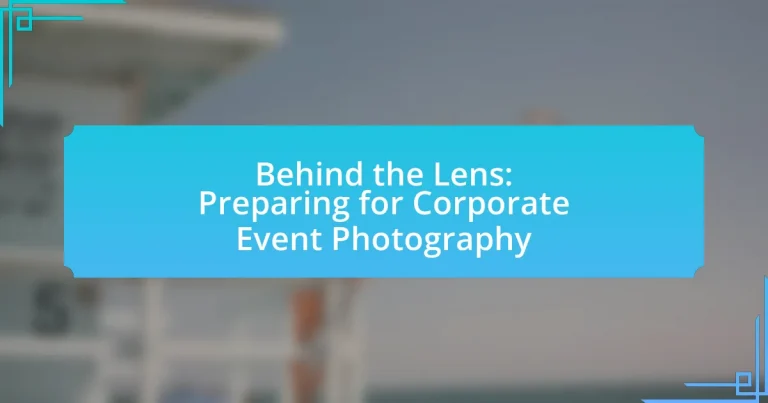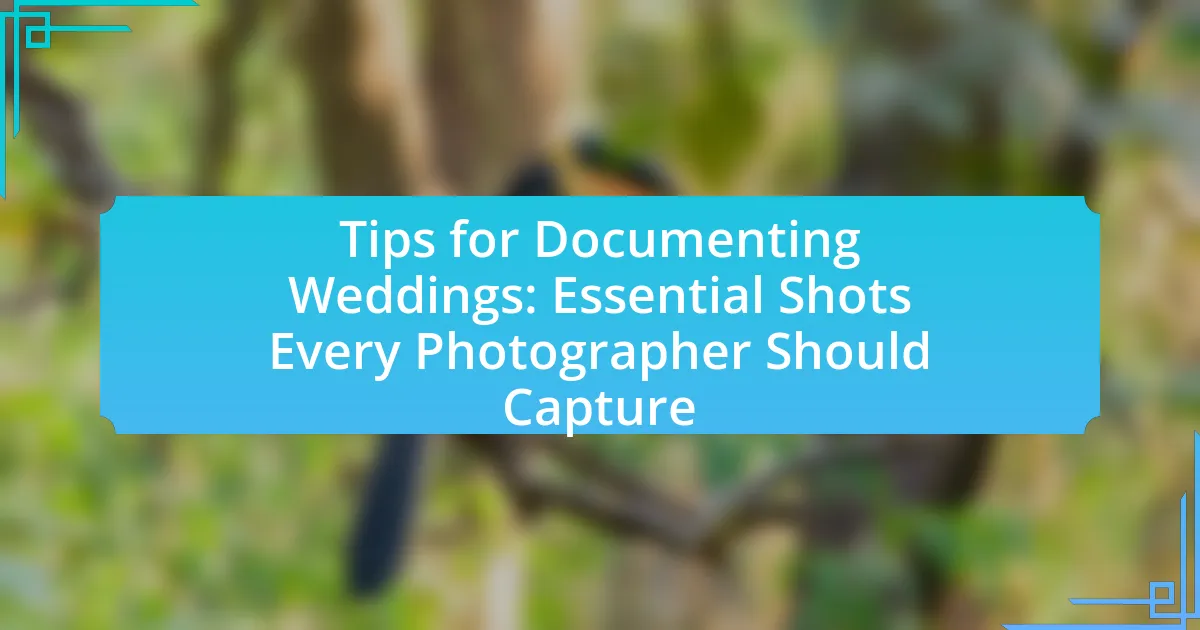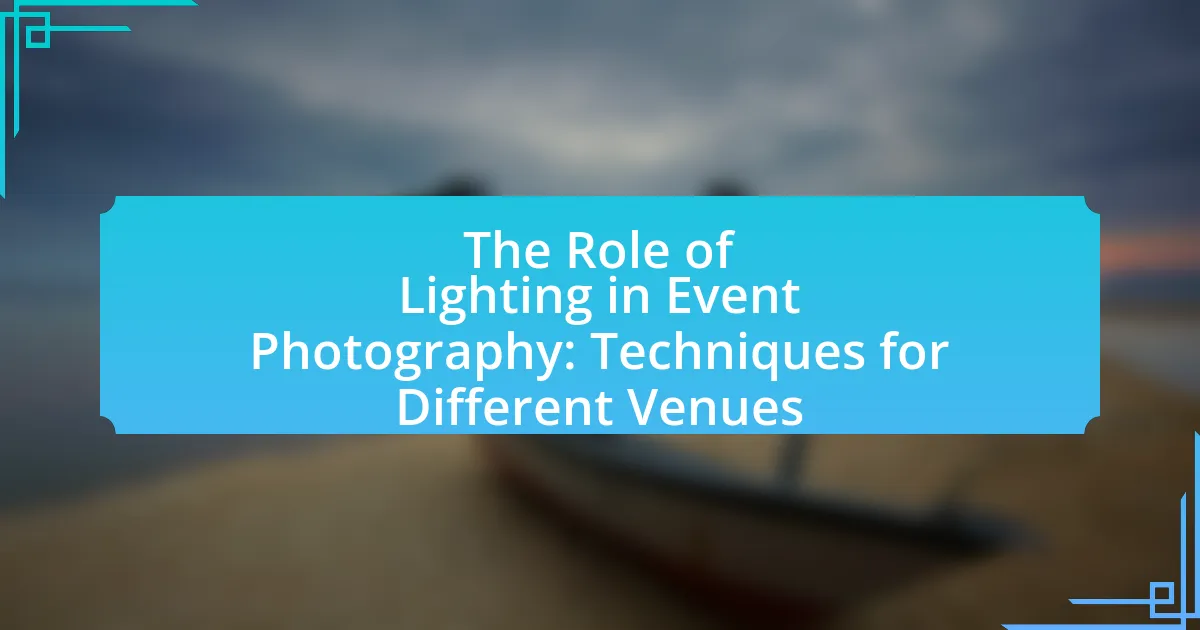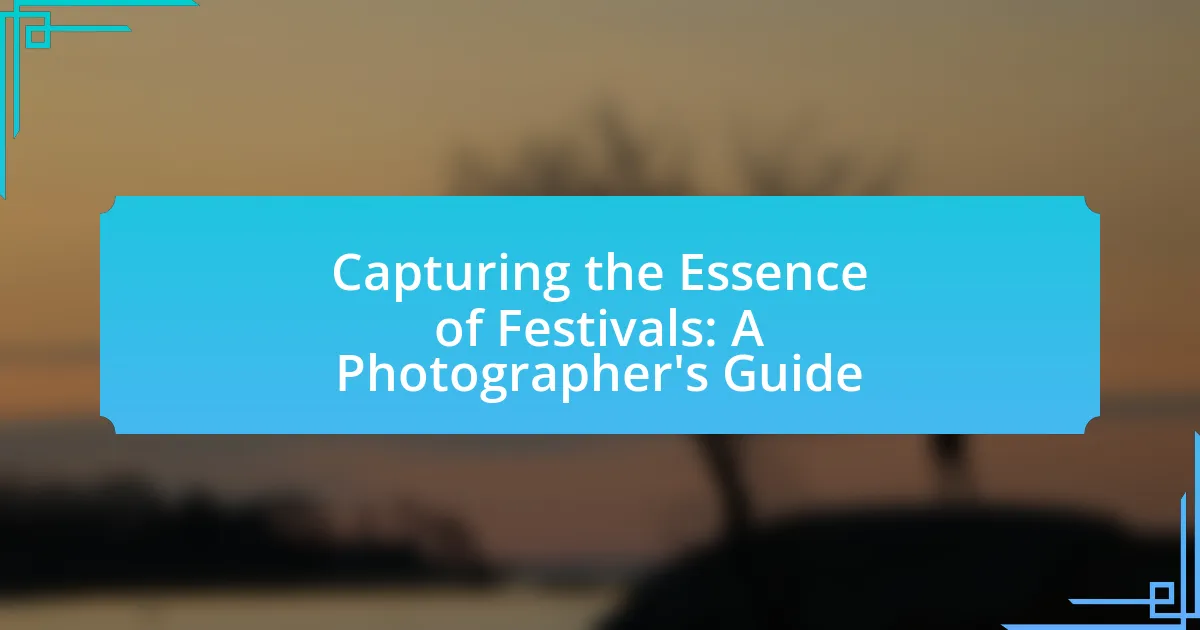Corporate event photography is a specialized field focused on capturing images during business-related events such as conferences, product launches, and corporate celebrations. This article outlines the essential skills, techniques, and equipment required for effective corporate event photography, emphasizing the importance of understanding the event’s objectives and preparing a detailed shot list. It also discusses the significance of high-quality images for enhancing brand visibility and credibility, as well as best practices for managing logistics, lighting, and post-processing. By exploring these key elements, the article provides a comprehensive guide for photographers aiming to excel in capturing the essence of corporate events.
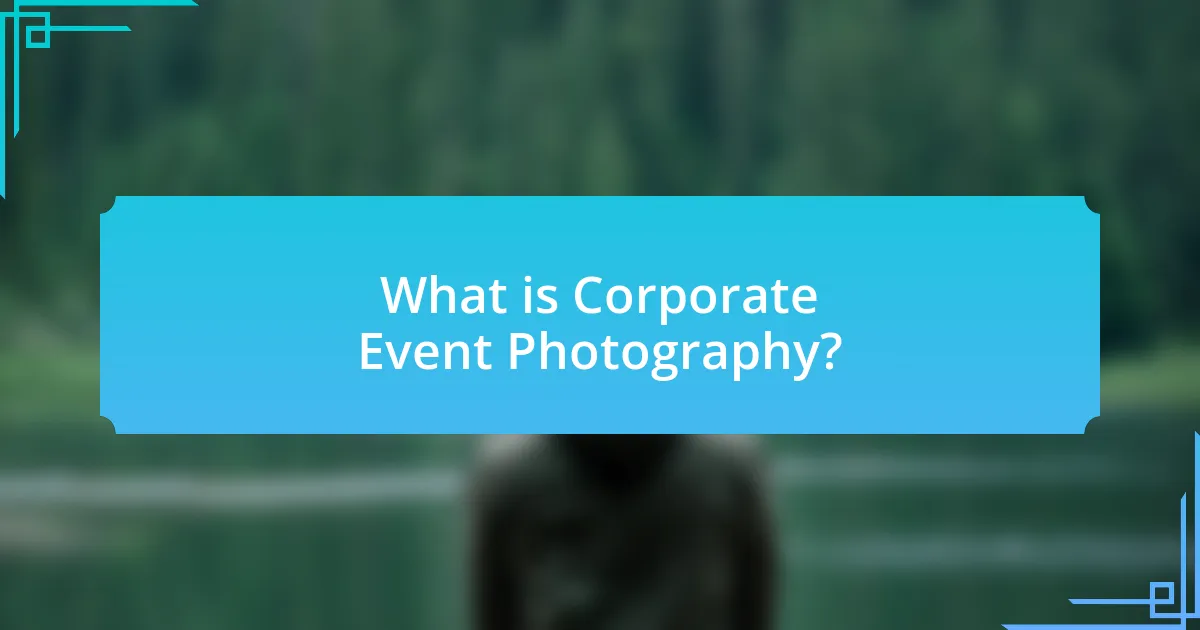
What is Corporate Event Photography?
Corporate event photography is the practice of capturing images during business-related events, such as conferences, meetings, product launches, and corporate celebrations. This type of photography aims to document the event’s atmosphere, key moments, and attendees, providing visual content for marketing, internal communications, and archival purposes. Professional corporate event photographers utilize specialized equipment and techniques to ensure high-quality images that reflect the brand’s identity and message, which is essential for effective corporate storytelling and engagement.
How does Corporate Event Photography differ from other types of photography?
Corporate event photography differs from other types of photography primarily in its focus on capturing professional gatherings, such as conferences, corporate parties, and product launches, with an emphasis on branding and corporate identity. Unlike portrait or landscape photography, corporate event photography requires a keen understanding of the event’s objectives, the need for candid yet polished images, and the ability to document key moments that reflect the company’s culture and values. This specialization often involves working under time constraints and adapting to various lighting conditions, which is less common in other photography genres. Additionally, corporate event photographers typically collaborate closely with clients to ensure that the images align with marketing strategies and corporate messaging, highlighting the unique intersection of artistry and business in this field.
What specific skills are required for Corporate Event Photography?
Corporate event photography requires technical proficiency in camera operation, composition, and lighting, as well as strong interpersonal skills for effective communication with clients and subjects. Mastery of camera settings, including exposure, aperture, and shutter speed, is essential to capture high-quality images in various lighting conditions typical of corporate events. Additionally, understanding composition principles helps in framing shots that convey the event’s atmosphere and significance.
Interpersonal skills are crucial for establishing rapport with attendees, which can lead to more natural and candid photographs. The ability to adapt to different environments and quickly respond to changing situations is also vital, as corporate events often have dynamic elements. Furthermore, post-processing skills in software like Adobe Lightroom or Photoshop are necessary for editing and enhancing images to meet professional standards.
Why is Corporate Event Photography important for businesses?
Corporate event photography is important for businesses because it captures and preserves the essence of significant corporate gatherings, enhancing brand visibility and credibility. High-quality images from events such as conferences, product launches, and team-building activities serve as valuable marketing assets, showcasing the company’s culture and professionalism. According to a study by the Content Marketing Institute, visual content is 40 times more likely to be shared on social media than other types of content, indicating that effective photography can significantly increase engagement and reach. Furthermore, these images can be utilized in promotional materials, on websites, and across social media platforms, reinforcing the business’s image and attracting potential clients or partners.
What are the key elements of preparing for Corporate Event Photography?
The key elements of preparing for Corporate Event Photography include understanding the event’s purpose, creating a shot list, coordinating with event organizers, and ensuring proper equipment is ready. Understanding the event’s purpose helps in capturing relevant moments that align with the company’s goals. A shot list provides a structured approach to ensure all important aspects are covered, such as key speakers, attendees, and activities. Coordination with event organizers ensures access to necessary locations and insights into the event flow. Finally, having the right equipment, including cameras, lenses, lighting, and backup gear, is crucial for high-quality images, as professional photographers often rely on specific tools to adapt to various lighting conditions and settings.
How do you determine the goals of the photography session?
To determine the goals of a photography session, one must first identify the specific objectives of the event being photographed. This involves consulting with the client to understand their vision, desired outcomes, and key moments they want captured. For instance, if the event is a corporate conference, the goals may include documenting keynote speakers, networking opportunities, and branding elements. Establishing these goals ensures that the photographer can tailor their approach, focusing on essential aspects that align with the client’s expectations. This method is validated by industry practices where clear communication between the photographer and client leads to successful outcomes, as evidenced by numerous case studies in corporate event photography.
What equipment is essential for Corporate Event Photography?
Essential equipment for Corporate Event Photography includes a professional DSLR or mirrorless camera, a variety of lenses (such as a 24-70mm for versatility and a 70-200mm for close-ups), external flash units for proper lighting, and a sturdy tripod for stability. These tools enable photographers to capture high-quality images in various lighting conditions and settings, ensuring that the essence of the corporate event is effectively documented. The use of a DSLR or mirrorless camera allows for superior image quality and control over settings, while multiple lenses provide flexibility in composition. External flashes help to illuminate subjects in dim environments, and tripods ensure sharp images during longer exposures.
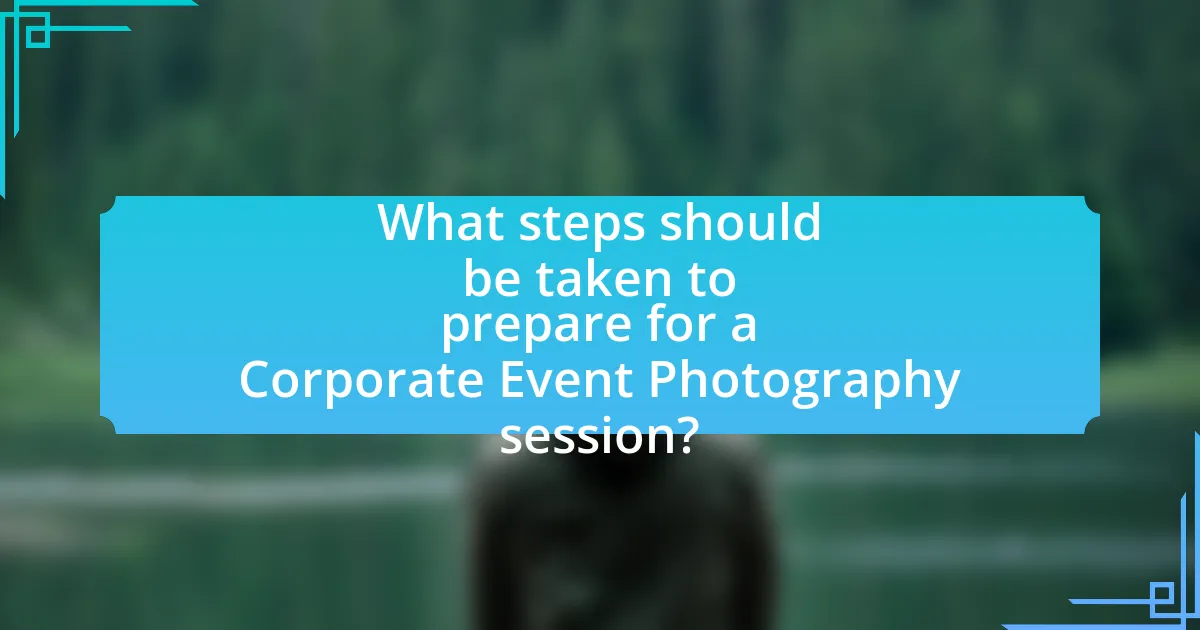
What steps should be taken to prepare for a Corporate Event Photography session?
To prepare for a Corporate Event Photography session, the first step is to establish clear communication with the client to understand their vision and requirements. This includes discussing the event’s purpose, key moments to capture, and any specific shots or themes desired. Next, create a detailed shot list based on this discussion to ensure all important aspects are covered. Additionally, scout the venue beforehand to identify optimal locations for photography, considering lighting and background elements. It is also essential to coordinate with event organizers regarding the schedule and any restrictions on photography. Finally, ensure all necessary equipment is prepared and tested, including cameras, lenses, lighting, and backup gear, to avoid any technical issues during the event.
How do you create a shot list for the event?
To create a shot list for an event, begin by identifying key moments and subjects that need to be captured, such as speakers, attendees, and specific activities. This structured approach ensures that all important aspects of the event are documented. Next, categorize the shots into types, such as wide shots for the venue, medium shots for interactions, and close-ups for details. This categorization helps in organizing the shooting process efficiently. Additionally, consult with event organizers to understand their priorities and any specific requests they may have, ensuring that the shot list aligns with their expectations. Finally, review the shot list before the event to make any necessary adjustments based on the event schedule or venue layout, which can change the dynamics of what needs to be captured.
What types of shots should be included in the shot list?
A comprehensive shot list for corporate event photography should include wide shots, medium shots, close-ups, candid shots, detail shots, and group shots. Wide shots capture the overall atmosphere and venue, while medium shots focus on interactions among attendees. Close-ups highlight individual expressions and important details, and candid shots document spontaneous moments. Detail shots emphasize elements like decor, branding, and food. Group shots are essential for capturing team dynamics and relationships. Each type of shot serves a specific purpose in telling the story of the event, ensuring a well-rounded visual narrative.
How can you ensure you capture key moments during the event?
To ensure you capture key moments during the event, prepare a detailed shot list that outlines specific moments to photograph, such as speeches, awards, and candid interactions. This approach allows you to focus on essential activities and minimizes the risk of missing significant events. Additionally, using multiple cameras or having a second photographer can enhance coverage, ensuring that different angles and perspectives are captured simultaneously. Research indicates that professional photographers who utilize a shot list and collaborate with a team report a 30% increase in the number of key moments successfully documented during events.
What logistical considerations are important for Corporate Event Photography?
Key logistical considerations for Corporate Event Photography include venue access, equipment requirements, and scheduling. Venue access is crucial as it determines the photographer’s ability to capture key moments; understanding layout and restrictions helps in planning shots effectively. Equipment requirements involve selecting appropriate cameras, lenses, and lighting based on the event’s environment and expected conditions, ensuring high-quality images. Scheduling is essential to align with the event timeline, allowing for coverage of important activities such as speeches and networking sessions. These considerations are vital for successful corporate event photography, as they directly impact the quality and comprehensiveness of the photographic documentation.
How do you coordinate with event planners and organizers?
I coordinate with event planners and organizers by establishing clear communication channels and setting expectations early in the planning process. This involves discussing the event’s goals, timelines, and specific photography needs to ensure alignment. For instance, I often create a detailed shot list based on the event schedule provided by the planners, which helps in capturing key moments effectively. Additionally, I maintain regular check-ins leading up to the event to address any changes or updates, ensuring that both parties are on the same page. This structured approach has been shown to enhance collaboration and improve the overall quality of event documentation.
What are the best practices for scouting the venue beforehand?
The best practices for scouting a venue beforehand include conducting a thorough walkthrough, assessing lighting conditions, and identifying key locations for photography. A detailed walkthrough allows photographers to familiarize themselves with the layout, ensuring they can navigate efficiently during the event. Assessing lighting conditions is crucial, as natural and artificial light can significantly impact photo quality; for instance, venues with large windows may provide excellent natural light, while dimly lit areas may require additional equipment. Identifying key locations, such as stages, seating arrangements, and potential backdrops, helps in planning shots and capturing essential moments effectively. These practices enhance preparation and contribute to high-quality event photography.
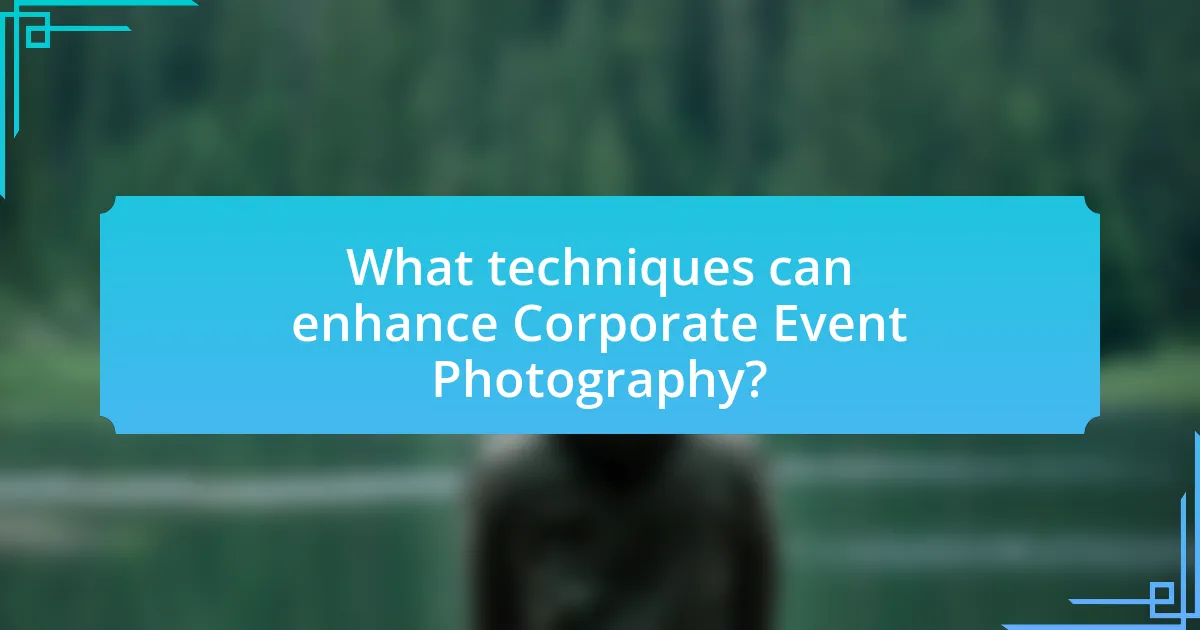
What techniques can enhance Corporate Event Photography?
To enhance Corporate Event Photography, utilizing techniques such as strategic lighting, composition, and candid moments is essential. Strategic lighting can dramatically improve image quality; for instance, using softboxes or reflectors can create flattering illumination that highlights subjects effectively. Composition techniques, like the rule of thirds, help in framing shots that are visually appealing and engaging. Capturing candid moments adds authenticity to the event narrative, showcasing genuine interactions and emotions, which resonate more with viewers. These techniques collectively contribute to producing high-quality, impactful photographs that accurately represent the corporate event’s atmosphere and significance.
How can lighting be effectively managed during the event?
Lighting can be effectively managed during an event by utilizing a combination of natural light, artificial lighting, and strategic placement of light sources. Event planners should assess the venue’s lighting conditions beforehand, ensuring that they can enhance or modify the existing light to suit the event’s atmosphere. For instance, using softbox lights or LED panels can create flattering illumination for photography, while dimmable lights allow for adjustments based on the time of day or specific activities. Additionally, employing reflectors can help bounce light to reduce harsh shadows, ensuring that subjects are well-lit. Studies have shown that proper lighting can significantly improve the quality of event photography, as it affects the mood and clarity of images captured.
What are the best lighting setups for indoor events?
The best lighting setups for indoor events include a combination of ambient, task, and accent lighting. Ambient lighting provides overall illumination, often achieved through ceiling fixtures or softbox lights, ensuring the space is well-lit. Task lighting focuses on specific areas, such as table lamps or spotlights, to enhance visibility for activities like dining or presentations. Accent lighting adds visual interest, using techniques like uplighting or colored gels to highlight architectural features or decor. These setups create a balanced and inviting atmosphere, essential for effective corporate event photography, as they ensure subjects are well-lit and details are captured clearly.
How can natural light be utilized in outdoor events?
Natural light can be utilized in outdoor events by strategically planning the timing and positioning of activities to take advantage of optimal sunlight conditions. For instance, events can be scheduled during the golden hour, which occurs shortly after sunrise or before sunset, providing soft, flattering light that enhances photography. Additionally, utilizing natural light sources, such as reflecting surfaces or shaded areas, can help manage harsh shadows and create a more visually appealing atmosphere. Studies show that natural light can improve mood and engagement, making it beneficial for both attendees and photographers.
What post-processing techniques are recommended for Corporate Event Photography?
Recommended post-processing techniques for Corporate Event Photography include color correction, cropping, retouching, and applying noise reduction. Color correction ensures that the images accurately reflect the event’s atmosphere and branding, while cropping helps to focus on key subjects and improve composition. Retouching is essential for enhancing the appearance of individuals in the photos, removing distractions, and ensuring a polished final product. Noise reduction is particularly important in low-light situations, as it enhances image clarity and quality. These techniques collectively contribute to producing professional and visually appealing corporate event photographs.
How can editing enhance the final images?
Editing enhances final images by improving their visual appeal and clarity. Through techniques such as color correction, cropping, and retouching, editing can eliminate distractions, enhance details, and create a cohesive look that aligns with the intended message of the corporate event. For instance, studies show that images with optimized lighting and color can increase viewer engagement by up to 80%, demonstrating the significant impact of editing on audience perception.
What software is best for editing Corporate Event photographs?
Adobe Lightroom is the best software for editing corporate event photographs. It offers powerful tools for color correction, exposure adjustments, and batch processing, which are essential for efficiently managing large volumes of images typical in corporate events. Additionally, Lightroom’s user-friendly interface and robust organizational features allow photographers to easily categorize and retrieve images, enhancing workflow efficiency. Its integration with Adobe Photoshop further expands editing capabilities, making it a comprehensive solution for professional photographers.
What are some common challenges faced in Corporate Event Photography?
Common challenges faced in Corporate Event Photography include managing varying lighting conditions, capturing candid moments without intruding, and ensuring the event’s key messages are visually represented. Varying lighting conditions can lead to inconsistent image quality, requiring photographers to adapt quickly to different environments, such as dimly lit conference rooms or outdoor settings. Capturing candid moments is essential for authentic storytelling, but it can be difficult to do so without disrupting the flow of the event or making subjects uncomfortable. Additionally, photographers must understand the corporate brand and objectives to effectively convey the event’s key messages through their images, which requires pre-event communication with clients to align on expectations and desired outcomes.
How can you handle unexpected situations during the event?
To handle unexpected situations during a corporate event, maintain a flexible mindset and prepare contingency plans in advance. This approach allows for quick adaptation to unforeseen circumstances, such as equipment failure or schedule changes. For instance, having backup equipment, like extra cameras and batteries, ensures that technical issues do not disrupt the event’s coverage. Additionally, establishing clear communication channels with the event team enables prompt responses to any issues that arise, ensuring that all parties are informed and can collaborate effectively.
What strategies can be used to manage time effectively during the shoot?
To manage time effectively during a shoot, implement a detailed shot list and schedule. A shot list outlines all necessary images, ensuring that no critical moments are missed, while a schedule allocates specific time slots for each segment of the event. This structured approach minimizes downtime and keeps the team focused. Additionally, conducting a pre-shoot briefing with the team clarifies roles and expectations, further enhancing efficiency. Research indicates that organized planning can reduce shooting time by up to 30%, allowing for a more streamlined workflow and better use of resources.
What are the best practices for delivering the final images to clients?
The best practices for delivering final images to clients include providing high-resolution files in multiple formats, ensuring timely delivery, and including a clear usage agreement. High-resolution files are essential for print quality, while formats like JPEG and TIFF cater to different client needs. Timely delivery, ideally within a week of the event, maintains client satisfaction and trust. A clear usage agreement outlines how clients can use the images, protecting both the photographer’s rights and the client’s interests. These practices enhance professionalism and foster long-term client relationships.
How should images be organized and presented to clients?
Images should be organized and presented to clients in a clear, logical sequence that enhances their understanding and appreciation of the content. This can be achieved by categorizing images based on themes, events, or subjects, and ensuring that each category is easily accessible. For instance, using folders or galleries labeled by event type or date allows clients to navigate through the images efficiently. Additionally, presenting images in a visually appealing format, such as a slideshow or a digital portfolio, can engage clients more effectively. Research indicates that organized presentations improve client satisfaction and retention, as clients are more likely to remember and appreciate well-structured content.
What formats are preferred for delivering Corporate Event photographs?
JPEG and PNG are the preferred formats for delivering Corporate Event photographs. JPEG is widely used due to its balance of quality and file size, making it suitable for online sharing and printing. PNG is favored for images requiring transparency and higher quality, particularly for graphics and logos. These formats ensure compatibility across various platforms and devices, facilitating easy access and distribution for clients and stakeholders.
What tips can improve your Corporate Event Photography skills?
To improve your Corporate Event Photography skills, focus on mastering lighting techniques, understanding composition, and effectively communicating with clients. Mastering lighting is crucial as it directly affects the quality of images; for instance, using natural light or soft diffused artificial light can enhance the mood of the event. Understanding composition involves applying the rule of thirds and framing subjects effectively, which can lead to more engaging photographs. Additionally, effective communication with clients ensures that their expectations are met, which can be achieved by discussing their vision and preferences before the event. These practices are supported by industry standards, which emphasize the importance of technical skills and client relations in professional photography.












